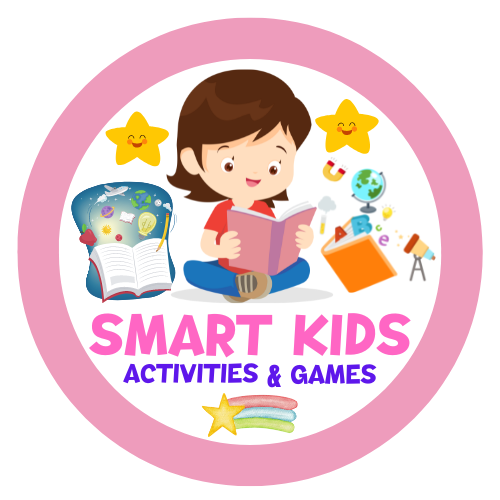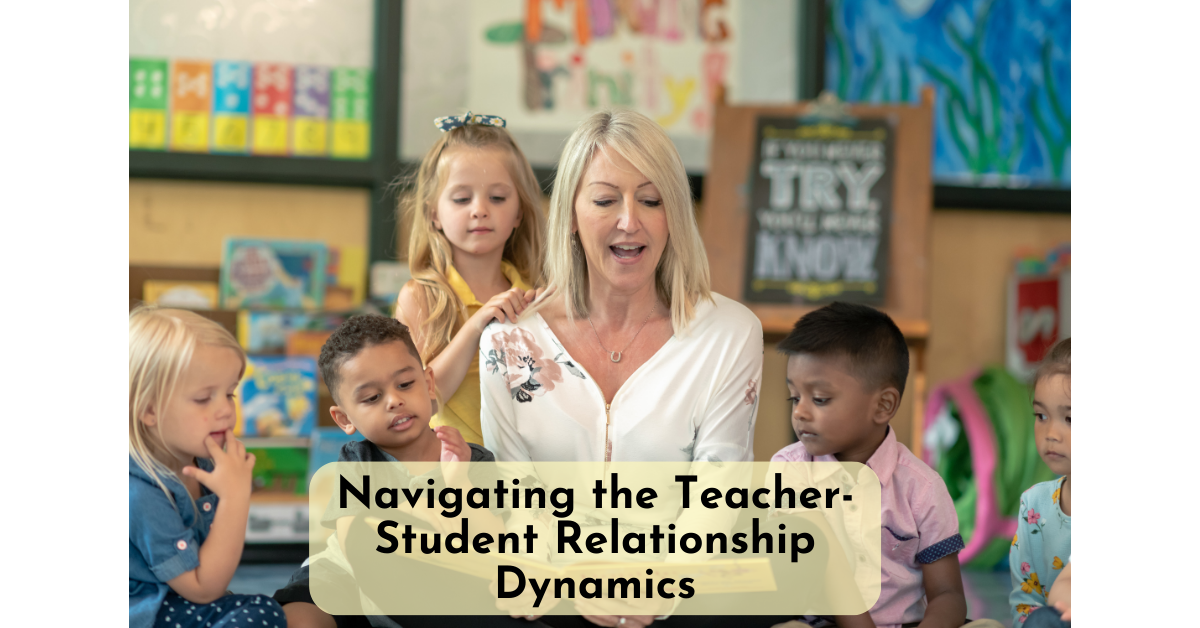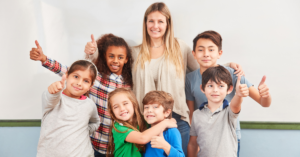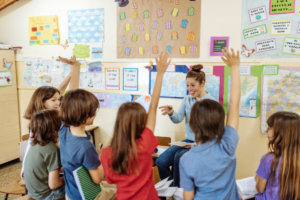Key Takeaways:
- A strong teacher-student relationship enhances academic performance, motivation, and engagement.
- Lack of support from teachers can lead to higher rates of class absenteeism.
- Building a strong teacher-student relationship helps create a supportive and engaging learning environment.
The Role of Mindfulness in Teacher-Student Relationships
Teacher mindfulness is a powerful tool for enhancing the teacher-student relationship and fostering emotional intelligence. By practicing mindfulness, teachers can develop a deeper understanding of the learning process and create a positive and supportive environment for their students. Mindfulness helps teachers maintain focus and be more attuned to the dynamics in the classroom, which leads to more meaningful interactions with students.“Mindfulness allows teachers to be present in the moment, to really listen to their students, and to respond with empathy and understanding.”When teachers are mindful, they are better able to recognize and manage their own stress and emotions, reducing the likelihood of negative reactions towards their students. This, in turn, enhances their emotional intelligence, allowing them to better understand and respond to their students’ emotional needs. Research has shown that teacher mindfulness positively impacts the teacher-student relationship and student outcomes. Teachers who practice mindfulness report experiencing less burnout and increased job satisfaction. They are also more compassionate, patient, and empathetic towards their students.
Mindfulness Practices for Teachers:
- Regular meditation or deep breathing exercises
- Engaging in reflective practices
- Practicing self-care and stress reduction techniques
- Using mindfulness-based classroom activities and techniques
Benefits of Mindfulness in Teacher-Student Relationships:
| Benefits for Teachers | Benefits for Students |
|---|---|
| Reduced stress and burnout | Increase in academic performance |
| Improved emotional well-being | Enhanced motivation and engagement |
| Increased empathy and understanding | Stronger sense of belonging and connection |
Strategies for Building Positive Teacher-Student Relationships
Building positive teacher-student relationships is essential for creating a supportive and engaging learning environment. Here are various strategies teachers can employ to foster trust, effective communication, empathy, and promote positive interactions:1. Initiating Small Talk
Initiating small talk with students allows teachers to establish a personal connection and build rapport. By showing genuine interest in their lives and experiences outside the classroom, teachers can create a friendly and welcoming atmosphere. Small talk helps to break the ice and lays the foundation for stronger teacher-student relationships.2. Using Humor in the Classroom
Humor can be a powerful tool in fostering positive teacher-student relationships. Using appropriate humor in the classroom lightens the atmosphere, promotes a sense of camaraderie, and helps students feel more comfortable engaging with the teacher. It enhances the learning experience and creates a positive emotional climate.3. Engaging Students in Dialogue Exchange
Encouraging meaningful dialogue exchange with students cultivates a sense of belonging and empowers them to express their thoughts and ideas. By creating an environment where students feel heard and valued, teachers can build trust and foster positive interactions. Dialogue exchange promotes active learning and critical thinking skills.4. Active Listening and Validating Student Opinions
Active listening involves giving students undivided attention, showing genuine interest in their perspectives, and validating their opinions. When students feel understood and respected, they are more likely to actively participate in class discussions and share their ideas. Active listening builds trust and fosters open communication.5. Maintaining an Optimal Student-Teacher Ratio
Maintaining an optimal student-teacher ratio allows teachers to provide individualized attention and establish deeper connections with each student. Smaller class sizes enable teachers to address the unique needs and learning styles of their students, promoting a more personalized and supportive learning environment.6. Demonstrating Genuine Concern and Fostering Open Exchanges
Building trust and rapport requires teachers to demonstrate genuine concern for their students’ well-being and academic progress. By actively engaging with students, offering guidance, and providing opportunities for open exchanges, teachers create a safe and supportive learning environment. This promotes positive interactions and a sense of belonging.| Strategies | Benefits |
|---|---|
| Initiating small talk | Establishes personal connection, builds rapport |
| Using humor in the classroom | Creates a positive emotional climate, fosters camaraderie |
| Engaging students in dialogue exchange | Cultivates a sense of belonging, empowers students |
| Active listening and validating student opinions | Builds trust, promotes open communication |
| Maintaining an optimal student-teacher ratio | Enables individualized attention and deeper connections |
| Demonstrating genuine concern and fostering open exchanges | Creates a safe and supportive learning environment |
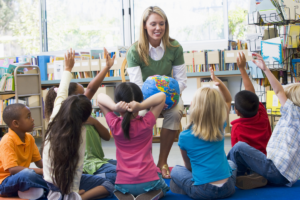
The Benefits of a Strong Teacher-Student Relationship
A strong teacher-student relationship has numerous benefits for both students and teachers. When students have a positive relationship with their teachers, they experience enhanced academic success, mutual growth, and improved student outcomes. This positive dynamic fosters a supportive and positive learning environment where both students and teachers can thrive. Students who have a strong connection with their teachers show higher levels of academic interest, dedication, achievement, self-efficacy, and motivation. They are more engaged in the learning process and exhibit improved social-emotional well-being. The positive relationship between teacher and student serves as a catalyst for individual growth and development, nurturing each student’s unique potential.“Building a strong teacher-student relationship is crucial for creating a supportive and engaging learning environment.” – Dr. Emma Robinson, Education SpecialistNot only do students benefit from a strong teacher-student relationship, but teachers also experience professional growth and fulfillment. By establishing meaningful connections with their students, teachers can derive a sense of purpose and job satisfaction. These positive relationships enhance teachers’ understanding of their students’ needs, allowing them to tailor their instruction and support for optimal student success. A strong teacher-student relationship contributes to a positive learning environment where students feel safe, supported, and valued. This nurturing environment promotes open communication, collaboration, and mutual respect, fostering a conducive space for learning and personal growth. Students are more likely to actively participate, ask questions, and take risks in their academic journey.
Benefits of a Strong Teacher-Student Relationship:
- Enhanced academic interest and dedication
- Improved achievement and self-efficacy
- Increased motivation and engagement in the learning process
- Improved social-emotional well-being
- Higher job satisfaction for teachers
- A more fulfilling and rewarding teaching experience
- Creation of a supportive and positive learning environment
- Increased student success and improved outcomes
Overcoming Challenges in Modern Teacher-Student Relationships
Modern teacher-student relationships face various challenges that can impact the quality and effectiveness of learning. It is essential for educators to navigate and overcome these obstacles to ensure a positive and productive learning environment for all students.Digital Distractions
The prevalence of digital devices has introduced a new form of distraction in the classroom. Students can easily become engrossed in their smartphones, tablets, or laptops, diverting their attention away from the teacher and the lesson at hand. This can hinder communication and engagement in the teacher-student relationship, making it difficult for educators to effectively convey information and facilitate meaningful discussions.Diverse Learning Preferences
Students have diverse learning preferences, and each student may have a different style or method that works best for them. Some students may excel in visual learning, while others may prefer auditory or kinesthetic learning. Accommodating these diverse learning preferences can be a challenge for teachers, as they strive to provide an inclusive and equitable learning experience for all students.Cultural and Generational Gaps
In today’s multicultural and multigenerational classrooms, cultural and generational gaps can create barriers to effective communication and understanding. Teachers must navigate these gaps to ensure that all students feel valued, respected, and included. Understanding and appreciating different cultural backgrounds and generational perspectives can foster a sense of belonging and strengthen the teacher-student relationship.Disruptive Behavior
Disruptive behavior in the classroom can significantly impact the teacher-student relationship and hinder the learning process. Examples of disruptive behavior include talking out of turn, disrespecting classmates or the teacher, and engaging in off-task activities. It is essential for teachers to address disruptive behavior promptly and implement proactive classroom management strategies to maintain a respectful and harmonious learning environment. To overcome these challenges, teachers must employ proactive strategies and promote open communication with their students. Building a strong teacher-student relationship based on trust, understanding, and respect is crucial. By addressing digital distractions, accommodating diverse learning preferences, bridging cultural and generational gaps, and effectively managing disruptive behavior, educators can create a supportive and engaging learning environment that maximizes student success.| Challenges | Strategies for Overcoming |
|---|---|
| Digital Distractions | Promote mindful tech usage, set clear boundaries, and incorporate technology purposefully to engage students while minimizing distractions. |
| Diverse Learning Preferences | Implement differentiated instruction, provide various learning modalities, and offer multiple avenues for student participation and assessment. |
| Cultural and Generational Gaps | Organize culture-sharing sessions, invite diverse perspectives, establish an inclusive classroom culture, and foster empathy and understanding among students. |
| Disruptive Behavior | Develop proactive classroom management strategies, clearly communicate expectations, establish consequences, and involve students in rule-setting to create a positive learning environment |
Strategies for Overcoming Challenges in Teacher-Student Relationships
In today’s modern educational landscape, teachers face various challenges in building and maintaining strong teacher-student relationships. These challenges include digital distractions, diverse learning preferences, cultural and generational gaps, and disruptive behavior in the classroom. However, with proactive strategies and a mindful approach, teachers can overcome these challenges and create a positive and inclusive learning environment. One strategy is to promote mindful tech usage. With the proliferation of technology in classrooms, it’s important to strike a balance and use technology mindfully. Teachers can encourage students to use technology purposefully for educational purposes and minimize distractions. By setting clear expectations and providing guidance on responsible tech usage, teachers can reduce digital distractions and enhance student engagement. Inclusive teaching practices are also key to overcoming challenges in teacher-student relationships. Recognizing that students have diverse learning preferences and needs, teachers can adopt inclusive teaching strategies that cater to a range of learning styles. This can include using different teaching methods, providing multiple means of representation and expression, and offering flexible learning options. By creating a learning environment that values diversity and inclusivity, teachers can foster an atmosphere of acceptance and appreciation.“Teachers have a unique opportunity to bridge cultural gaps, foster cultural understanding, and create a sense of belonging in the classroom.”Fostering cultural understanding is another important strategy. In today’s multicultural and global society, classrooms are becoming more diverse. It is essential for teachers to promote cultural understanding and bridge generational gaps to create an inclusive learning environment. Organizing culture-sharing sessions, inviting guest speakers from different backgrounds, and incorporating diverse perspectives into the curriculum can help students develop empathy, respect, and appreciation for cultural differences.
Proactive Classroom Management Strategies
| Proactive Classroom Management Strategies | Description |
|---|---|
| Setting clear expectations | Establishing and communicating clear behavior expectations and rules to students to create a positive and structured learning environment. |
| Involving students in rule-setting | Engaging students in the process of creating classroom rules, fostering a sense of ownership and responsibility. |
| Implementing positive reinforcement | Recognizing and rewarding positive behavior to motivate students and reinforce desired classroom norms. |
| Addressing disruptive behavior proactively | Proactively addressing disruptive behavior by using non-punitive approaches such as redirecting, restorative practices, or positive behavior interventions. |
The Significance of Teacher-Student Relationships in the 21st Century
In the fast-paced world of the 21st century, teacher-student relationships have taken on a new level of significance. With a vast amount of information readily available, teachers now play the role of intellectual mentors, guiding students through the maze of knowledge. A strong teacher-student relationship forms the foundation for personalized guidance and enriched learning experiences. By understanding each student’s unique needs and perspectives, teachers have the power to tailor their mentorship and empower students to thrive both academically and personally. Gone are the days of simply delivering information; teachers are now tasked with teaching students how to assess the quality of information and integrate knowledge into their lives. Through personalized guidance, teachers provide individual attention and support to help students navigate complex concepts and develop critical thinking skills. They create a safe space where students can engage in meaningful discussions, ask questions, and explore their interests. Enriched learning experiences emerge from the strong bond between teachers and students, fostering a deep sense of trust and collaboration.Fostering Personalized Guidance
Personalized guidance involves recognizing and addressing each student’s unique strengths, weaknesses, and learning styles. It encompasses providing differentiated instruction, individualized feedback, and tailored support. By acknowledging the diverse needs of their students, teachers can help them unlock their full potential. “Mrs. Johnson always takes the time to understand how I learn best. She provides resources that cater to my individual needs, allowing me to develop my skills and build confidence.” – Sarah, 10th grade student.Creating Enriched Learning Experiences
Enriched learning experiences go beyond textbooks and lectures. They involve hands-on activities, collaborative projects, and real-world applications. Teachers who cultivate strong relationships with their students create an environment where exploration, experimentation, and creativity thrive. “Mr. Davis encourages us to think critically and explore different perspectives, which has made learning more engaging and inspiring. He challenges us to apply our knowledge in real-life scenarios, helping us see the relevance of what we’re studying.” – Kevin, 11th grade student.The Evolving Role of Teachers
In the ever-evolving landscape of education, the role of teachers has transformed. They are no longer the sole source of information, but facilitators of learning. Teachers guide students in acquiring the essential skills of critical thinking, problem-solving, and information evaluation. “Ms. Rodriguez doesn’t just teach us facts; she teaches us how to think. She encourages us to question, analyze, and evaluate information independently. Her guidance has prepared me for the challenges of the future.” – Emma, 12th grade student.| Benefits of Strong Teacher-Student Relationships in the 21st Century |
|---|
| 1. Personalized guidance tailored to individual student needs |
| 2. Enriched learning experiences that foster critical thinking and creativity |
| 3. Preparation for the evolving demands of the modern world |
Conclusion
The importance of the teacher-student relationship cannot be overstated. It is a vital aspect of the educational experience that has a significant impact on academic success, student outcomes, and the overall learning environment. By nurturing strong teacher-student relationships, educators can create a supportive and engaging atmosphere that benefits both students and teachers. Mindfulness and effective communication are key elements in enhancing these relationships. Teachers who practice mindfulness are better equipped to understand the needs of their students and foster positive interactions. By promoting open and effective communication, teachers can build trust and create an environment where students feel heard and valued. Overcoming challenges is also crucial in strengthening the teacher-student relationship. By addressing digital distractions, accommodating diverse learning preferences, fostering cultural understanding, and implementing proactive classroom management strategies, teachers can create an environment that is conducive to positive relationships and academic success. In conclusion, prioritizing the teacher-student relationship is essential. By investing in building strong connections, practicing mindfulness, fostering effective communication, and overcoming challenges, educators can create an environment that supports academic success, positive interactions, and a love for learning.FAQ
What is the importance of the teacher-student relationship?
The teacher-student relationship is crucial for creating a supportive and engaging learning environment. Research shows that when students feel connected to their teachers, it leads to better academic performance, motivation, and student engagement.
How can mindfulness benefit the teacher-student relationship?
Mindfulness enables teachers to maintain focus, understand the learning process, and be more attuned to classroom dynamics. It helps reduce teacher stress and despair, leading to more positive interactions with students and creating a supportive emotional climate in the classroom.
What strategies can teachers use to build positive relationships with their students?
Teachers can initiate small talk, use humor, engage students in dialogue exchange, practice active listening, and validate student opinions to foster rapport and build trust. Maintaining an optimal student-teacher ratio and demonstrating genuine concern also contribute to creating a safe and supportive learning environment.
What are the benefits of a strong teacher-student relationship?
A strong teacher-student relationship leads to higher academic interest, dedication, achievement, self-efficacy, and motivation in students. It also improves social-emotional well-being and fosters a positive learning environment. For teachers, it enhances job satisfaction and creates a more fulfilling teaching experience.
What challenges do modern teacher-student relationships face?
Modern teacher-student relationships face challenges such as digital distractions, diverse learning preferences, cultural and generational gaps, and disruptive behavior in the classroom. These challenges impact communication, understanding, and learning in the teacher-student relationship.
How can teachers overcome challenges in the teacher-student relationship?
Teachers can promote mindful tech usage to reduce digital distractions, adopt inclusive teaching practices to accommodate diverse learning preferences, organize culture-sharing sessions to foster cultural understanding, and implement proactive classroom management strategies to address disruptive behavior.
Why are teacher-student relationships significant in the 21st century?
In the 21st century, teacher-student relationships have become even more significant as teachers guide students through the vast amount of information available to them. A strong teacher-student relationship provides the foundation for personalized guidance and enriched learning experiences, empowering students to succeed academically and personally.
What is the significance of the teacher-student relationship?
Nurturing strong teacher-student relationships leads to academic success, improved student outcomes, and a positive learning environment. By prioritizing the teacher-student relationship, educators can create a supportive and engaging learning environment that benefits both students and teachers.
Download free activities and teaching resources Click Here
You may also be interested in
AI in Kids Education: Trends & Benefits
The Importance of Teacher-Student Relationships
Handling Difficult Student Behavior: 10 Tips & Strategies
The Importance of Parent-Teacher Collaboration
Boost Your Brain: 10 Ways to Improve Learning Skills
Exploring Technology’s Role in Education Today
Source Links
- https://www.suraasa.com/blog/teacher-student-relationship
- https://www.ncbi.nlm.nih.gov/pmc/articles/PMC3399930/
- https://www.frontiersin.org/articles/10.3389/fpsyg.2023.1301786

